#god kirby concepts are so fun to chew on
Text
let’s do some autistic meta knight headcanons!! over explaining my interpretation of meta knight yet again wooooo
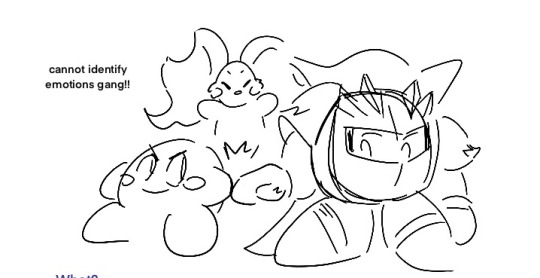
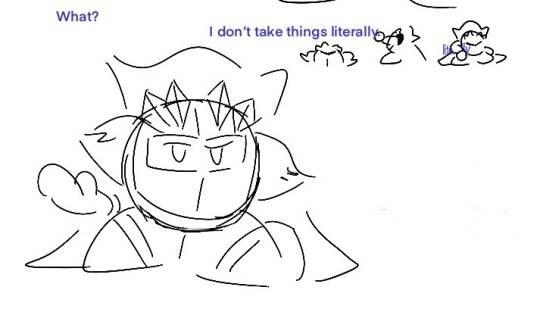
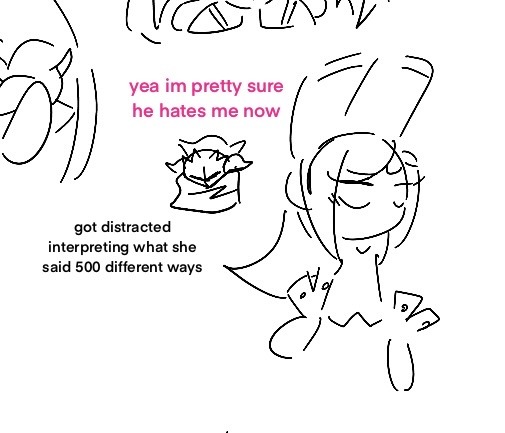

this orb has NO idea how to talk to people!!! outside of work anyway. a lot of this is partially due to upbringing (suppressing his emotions all the time) but he does not know how to express emotions, like…at all.
this goes into a few things
1. yeah talking is hard. even after figuring out what he wants to communicate he will struggle. conversation can be so overwhelming, especially under pressure. he will need time lol
2. because of that, forming connections is hard. i really don’t think meta is much for shallow relationships, and certainly not early in the timeline. which also means he has very little experience with friendship. so a lot of the relationships he did have went kinda neglected, and issues that probably could’ve been worked on by talking became…*cough romk* escalated.
3. honestly i wouldn’t be surprised if meta convinced himself he couldn’t feel emotion (anymore) until like. katam-ish. he tried very hard lol
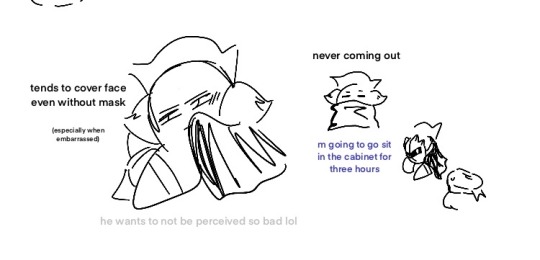
vulnerability is terrifying. (though this gesture here is also just comforting, like his little cape cocoon thing he does.)
unmasking—yeah im taking the mask thing very literally here—is a big deal and a very slow process for mk. i’m sure he has a lot of feelings on that lol. it served as a way to ensure no one could ever, y’know, see him.
i can’t say i think he’d ever fully ditch it—there’s always gonna be some days that are more stressful than others and if having it could help him get through it, it just makes sense. mainly when working.
it really is about vulnerability. granted, i don’t think he has the most expressive face (in my head every astral just tends to stare at things) but i doubt he has much control over it. can’t fake a smile but also can’t hide it. probably blushes easy because yeah, astrals; just look at kirby’s face.
just the idea that someone might be able to read his expression and know what he’s feeling before he’s ready for them to (or even understands it himself…) yeah he doesn’t want that
but emotional turmoil aside, i think his mask also hides a lot of his stims
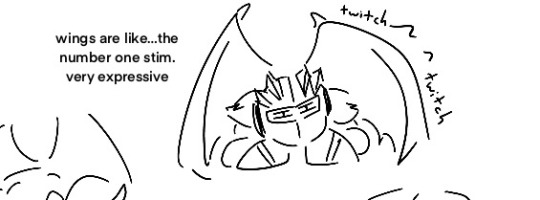

remember that whole “suppressing your feelings” thing? yeah turns out that ignoring half your instincts isn’t a good idea. so in true meta knight style, he tries to stim as subtly as possible
1. he has the least control over his wings, so they will flick and twitch on their own. they’re usually a good indicator of how he’s feeling, not unlike the body language usually seen in cat ears and tails lol. flapping is also an extension of this of course, though he probably suppresses it more.
2. this also effects when he takes his wings out. pretty much every time he’s excited or nervous it just happens. kinda makes me wonder if his wing cape ordeal might also go into the suppression thing… (i’d say yes, but using a cape is also very comforting so it’s not necessarily a bad thing)
3. going back to the mask thing; he stims a lot underneath it. think like biting or pursing your lips. he bites his tongue and clicks his mouth. that sort of thing. his mask also makes it harder to notice that he is constantly sighing, humming, grumbling…all that
one nice thing about the mask though is that it helps a little bit with lights!!! woo

(look at him and his magically floating glasses)
sensory stuff—i think he’s mostly bothered by light and sound. maybe a bit of texture. he’s pretty sensory avoidant and perfectly happy standing off to the side not touching anything.
the one exception to this is physical affection, which is, despite all of this, most of how he shows affection. it’s a lot easier to hug someone than to try to explain your feelings for them, after all.
i think he would like pressure though. so that’s probably part of it. and i’m pretty sure there’s some connection in here to fighting (dang, is that the only way he knows how to get his energy out?)
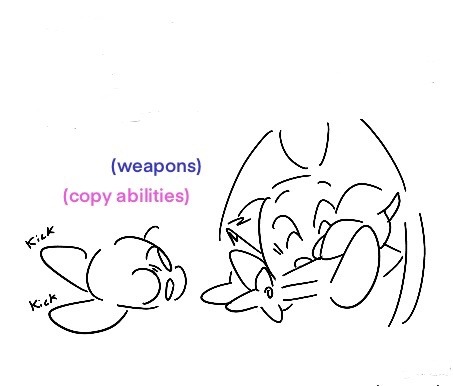
anyway, pretty much all of this is in contrast to kirby, who i would gladly nominate as the champion of Doing Whatever He Wants. he might pick up a few bad habits, but he will never mask the way meta knight does. he might not understand how he feels, but he’s in tune enough to express it…usually.
this is a very good thing for meta because it helps him to do the same thing. kirby’s so energetic, it’s hard to not want to stim with him. it reminds meta to be kinder to himself and explore his own emotions. he can also help kirby understand themselves, so this connection is very important.
yeah, at the end of the day, everything kinda just boils down to kirby and mk as parallels
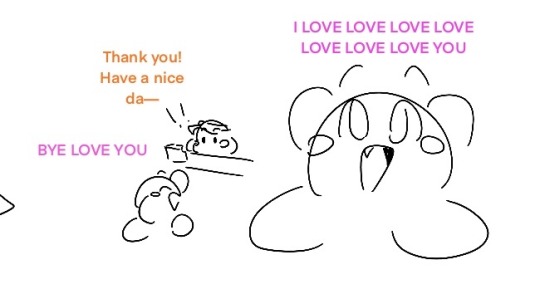
this is the conclusion i promise
to me, meta’s arc is about growing stronger by growing kinder, and this is mostly by learning to be kind to himself. letting himself be a person again, loving and understanding other people, and eventually, letting go of all the expectations placed on him and doing the things he’s always wanted to do…
autism headcanons are fun for me because it’s cathartic to write, but at the same time, it just makes sense in this sort of narrative. meta is, to me, inseparable from these things. and so is kirby! that’s a dynamic that’s a lot of fun to play with, and it’s at the heart of my kirby interpretation.
if you actually read all this WOW thank you
#i almost considered not posting this on a wednesday but then i wrote everything and uhhh yeah i think i gotta so#happy cringe day wednesday#for as many notes as i have on these characters i really don’t talk about it much#but meta knight is a special case because i am terrible at subtlety and he wouldn’t be meta knight without it#so this is to contextualize some things#because of what ill have in the next few days haha#basically these are just things i consider when writing meta#but a lot of it is subtextual and i dont know how well it comes across#kirbyposting#kirby#meta knight#headcanons#autism headcanon#this is practically an essay lol oops#i have like 2/3 of a fic that explores most of this in a way i probably won’t do again#but we’ll see if i ever finish it#god kirby concepts are so fun to chew on#i overthink everything i make so much lol
429 notes
·
View notes
Text
Reading X-Men: Uncanny X-Men 1-3

It’s been a long standing project of mine to finally read (and think) through the entirety of Uncanny X-Men (and many of its offshoots). I’ve tried a few times to start, but of course, I get hung up. Well, I’m not really going to buckle down and do it, even if it takes me the decade (which it probably will.)
So, let’s start at the beginning -- the Silver Age of Comics, a time in the early 60s when comics were bright and colorful, and clearly targeted towards a very specific demographic of white, upper middle class boys ages 8-12. I can’t say I’m a huge fan of this era of comics (even the most beloved titles such as Fantastic Four and Spider-Man), but that doesn’t mean we can’t find fun things to talk about here either.
X-Men was one of the last titles Stan Lee created in his golden age with Marvel Comics, and his attempt to create a superhero team made up entirely of teenagers (as a way to get kids to relate?), and was drawn, infamously, by Jack Kirby. Was the book any good? Meh, X-Men consistently had the lowest sales, and it’s not a surprise that it was cancelled by 1970. But the whole idea of Mutants, of people being ostracized for being born different, is a concept that still very resonant today.
X-Men Issues 1-3
The first three issues of the book aren’t much to write home about. Pretty much all of Stan Lee’s comics have the same similar feel to them, and a structure that’s nearly unwavering. The X-Men are introduced (usually by training in the Danger Room), the outlandish villain is introduced, the X-Men fight the villain and lose, the X-Men fight the villain and win. The end. Not very sophisticated these books. But they didn’t have to be -- kids just needed to read them. Silver Age was less about story, and more about fun action sequences drawn on the page.
So, let’s talk about the original line up of X-Men:
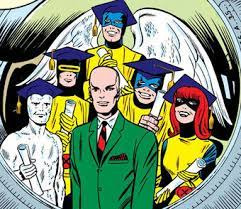
Professor Charles Xavier: Founder of the X-Men. He’s a rich, invalid guy who decided he wants to train teach younger members of homosuperior (yes, mutants are considered a different race) how to use their abilities to fight crime. Because why not? His mutant ability telepathy, telekinesis, and any other mind power you can think.
Like pretty much all of the characters in the first few issues, he doesn’t have much personality. He spends a lot of his time yelling at the X-Men through telepathy and having uncomfortable feelings about Jean Grey. (Okay, it’s one panel, but my god, why??) He also starts the series by having some serious issues with ethics, as he scrambles people’s minds without much thought.
Scott Summers (Cyclops): The moody and broody ‘leader’ of the team. He doesn’t do much but angst over the fact that his eyes shoot dangerous energy (not laser!) beams, and he could seriously danger anyone at any second.
Warren Worthington III (Angel): The wealthy, playboy with wings attached to his back. His most prominent skills are being that dude whom every woman rolls her eyes at and being able to dodge shit.
Henry (Hank) McCoy (Beast): A jovial and loquacious oldest member of the team, who is supposed to sprout irony, being the most intelligent while his mutant power is being beast-like.
Robert (Bobby) Drake (Iceman): The youngest and “coolest” member of the team, who is often incredibly juvenile and uses his ice powers to joke around. (Bobby’s much, much later going to come out as gay, which adds an extra fascinating (and sometimes hilarious) layer onto his Silver Age persona.)
Jean Grey (Marvel Girl): Jean gets to be the token girl back in an era when having a girl on the team was considered diverse. I like Jean in general, but the unfortunate downside to her being a girl in a Silver Age comic is that she doesn’t get much to do. She’s often regarded as being the weakest based solely on the fact that she’s a girl, despite the fact that she’s a telekinetic, and will eventually be one of the most powerful characters in the Marvel Universe. She doesn’t get to do a whole lot other than be oogled by the guys on the team, and faint after she exerts a minimal amount of power on panel, often needing one of the men on the team to save her.
It does get better, and I’m glad she’s at least around, but you can tell comics still had a long way to go.
***
Like I said above, the structure of Silver Age comics is pretty much the same, and it really comes down to the villain of the week. So, the villains of the first three issues:
Magneto: Long before Magneto’s tragic backstory is developed, before his long standing somewhat homoerotic friendship with Xavier is explored, and before his name is even established, Magneto makes his mark as being the first supervillain the X-Men ever fight. He’s already in his classic red and purple costume, using his questionable powers of magnetism to screw around with nuclear bombs and threaten the world.
And he’s an absolute delight. He’s cheesy and the epitome of supervillain scenery chewing. Do his powers make sense? Not really. Does he really accomplish anything by blowing the world up? Nope. But at least he’s ridiculous and fun, and memorable enough to become the most iconic villain in X-Men’s canon.
Vanisher: Magneto’s followed up by the somewhat bland Vanisher, whose outfit is totally killer, but otherwise an idiot. The Vanisher’s power is to teleport (like Nightcrawler), and his brilliant plan is to steal secret plans from the government. (He also decides to recruit a following - which is kind of hilarious.) The X-Men aren’t really able to stop him, so Xavier steps in to wipe his mind. Cause you know. Ethics.
The Blob: While the Vanisher is forgettable, and won’t really be remembered, The Blob ends up sticking around, albeit in smaller villainous roles. The Blob’s whole schtick is that he’s a huge dude and nothing can really hurt him. The X-Men try to “save” him from the circus, but the Blob is just one obnoxious dude, and isn’t really about being trained for Xavier’s mutant army, so he decides to head back to the circus. And then gets his circus friends to attack the X-Men (why, I don’t know). But because Stan Lee keeps writing himself into a corner, Xavier, once again, wipes the guy’s mind.
And that’s really it - the first three issues of The X-Men! Whoo! :)
8 notes
·
View notes